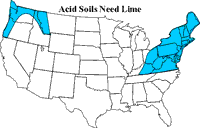Dealing With Acidic Soil
Whether your soil is acidic or alkaline the only long term technique to adjust pH is to add lots of organic matter to the soil year in and year out; it is called mulch.
Lime Will Increase Soil pH
If your soil is too acidic then applying garden lime will bring that pH up to the desired level; usually to 6.8 which is best for most plants.
Adding Limestone If Needed
There are only a few areas of the country where the soils tend to be very acidic. If you don't live in one of those areas, then be very careful about adding lime to your soil. You might be making a mistake; double check the pH reading. If you do live in one of these areas, consider the use of lime as only the short term fix. If you add organic matter to that soil every year, the pH will move to neutral even though the rest of the area is still acidic.

Most plants grow best in soils that are only slightly acidic, preferring a pH range of 6.0 to 7.2 (7.0 is neutral). It is easy to treat overly acidic soil by spreading a layer of limestone over the soil. Limestone is naturally alkaline and it buffers the excess acid in the soil sort of like an antacid tablet relieves acid stomachs in humans. The primary reason to have the soil within the preferred pH range is to keep the microbial population happy. An acidic soil discourages microbes and therefore provides fewer nutrients for the grass plants.
In addition to sweetening it, lime does many more good things for soil than people realize. It adds valuable calcium and magnesium to the soil, contributes to an improved soil structure and enhances seed germination. We recommend that you lime your lawn at least every three years even if the pH is okay; your grass needs the calcium and magnesium and can get it no other way! There are many types of lime available in garden centers and hardware stores.
Chose dolomitic lime in as fine a grind as you can find. The finer the granules, the faster it will take effect. It may be gray or tan or off-white, but it must be labeled truly dolomitic lime. Some retail outlets sell bags of limestone labeled as dolomitic, but they are basically only ground marble. Since it takes at least 3 to 6 months for limestone to be absorbed in the soil and take effect, the very best time to spread it is the fall. However, it is OK to lime anytime. If your soil is very acidic (below 5.2) then you will want to apply limestone in both the spring and the fall for several years. As the pH works its way up to the ideal level, cut back to once a year or even once every two years.
Generally speaking, shady areas of your property are more likely to be acidic and therefore will more likely need lime every year. Sandy soils that are within the proper pH range will need to be limed lightly about every 2 to 3 years. Clay soils that are within the proper pH range require heavier doses at least every 5 to 6 years. One last note on lime. Do not spread it on the lawn at the same time you fertilize. The chemical combination produces ammonia gas which releases the nitrogen you want for the grass into the air.
More Discussions In Yardener About Using Lime
Espoma Organic Traditions Garden Lime - 5 lb Bag GL5
by Espoma
GL5 Features: -Organic traditions garden lime. -The finest grade of pelletized, dolomite limestone available. -Adjusts soil ph so plants can get the most from nutrients present. -Fine pellets spread easily, react quickly and do not pose the hazards associated with hydrated lime. -5 lbs.
Rain Grow Get a Lawn Liquid Lime 38.8 Oz.
- Green Lawns and Gardens
- Covers 2500 square feet
- Liquid concentrate
Get-A-Lawn, Gallon, Natural Lime, Fast Acting Liquid Lime RTS WIth Hose End Sprayer, Covers 2500 SQFT.

